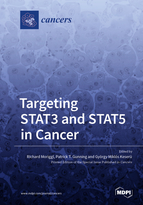Targeting STAT3 and STAT5 in Cancer
A special issue of Cancers (ISSN 2072-6694).
Deadline for manuscript submissions: closed (30 September 2019) | Viewed by 146625
Special Issue Editors
Interests: cytokine signaling; JAK-STAT pathway; basic and translational cancer research; targeting transcription factors; core cancer pathways; chromatin remodeling
Interests: molecular therapeutics; drug discovery; medicinal chemistry; protein–protein interactions; JAK–STAT pathway
Special Issue Information
Dear Colleagues,
Cancer is driven by hyperactivation of the JAK–STAT core cancer pathways associated with inappropriate functions of normal signaling pathways involving cytokine, growth factor and hormone action. The successful implementation of clinically approved JAK kinase inhibitors (baracitinib, ruxolitinib and tofacitinib) is proof that JAK–STAT targeting is beneficial. Consequently, targeting oncogenic transcription factors of the STAT family, namely STAT3, STAT5A and STAT5B as major funnels for gene regulatory processes including chromatin remodeling facilitated by them has therapeutic power. STAT3/5 proteins are attractive targets for drug discovery since they steer proliferation, survival and metabolism. Targeting protein-protein interactions, however, is challenging since the interacting surfaces are typically large and flat, having non-contiguous binding hot spots and lack of deep tractible pockets. Furthermore, targeting transcription factors is considered “undruggable”. Emerging drug design strategies and medicinal chemistry approaches, including methods to impair function, to destabilize or degrade transcription factors or to interfere with interaction partners and cofactors, initiated new concepts. Here, we summarize targeting approaches on STAT3/5, where the field moves into clinical application. We cover the design paradigms and medicinal chemistry approaches to illuminate limitations in specificity, potency, and in vivo bioavailability, necessitating approaches.
Focus of this special issue:
STAT3/5 activation is at the convergence point of many signaling pathways, activated by a plethora of upstream kinases and STAT3- and STAT5-targeting approaches in cancer is up for article invitation for this Special Issue.
Prof. Dr. Richard Moriggl
Prof. Dr. Patrick Gunning
Prof. Dr. György Miklós Keserü
Guest Editors
Manuscript Submission Information
Manuscripts should be submitted online at www.mdpi.com by registering and logging in to this website. Once you are registered, click here to go to the submission form. Manuscripts can be submitted until the deadline. All submissions that pass pre-check are peer-reviewed. Accepted papers will be published continuously in the journal (as soon as accepted) and will be listed together on the special issue website. Research articles, review articles as well as short communications are invited. For planned papers, a title and short abstract (about 100 words) can be sent to the Editorial Office for announcement on this website.
Submitted manuscripts should not have been published previously, nor be under consideration for publication elsewhere (except conference proceedings papers). All manuscripts are thoroughly refereed through a single-blind peer-review process. A guide for authors and other relevant information for submission of manuscripts is available on the Instructions for Authors page. Cancers is an international peer-reviewed open access semimonthly journal published by MDPI.
Please visit the Instructions for Authors page before submitting a manuscript. The Article Processing Charge (APC) for publication in this open access journal is 2900 CHF (Swiss Francs). Submitted papers should be well formatted and use good English. Authors may use MDPI's English editing service prior to publication or during author revisions.
Keywords
- STAT3
- STAT5A
- STAT5B
- JAK kinases
- oncogene induction
- metabolism
- chromatin remodeling
- blockade of dimer formation







